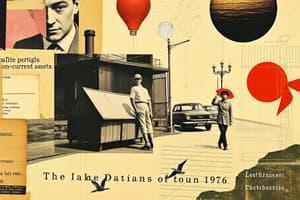Podcast
Questions and Answers
What is the primary characteristic that distinguishes non-current assets from current assets?
What is the primary characteristic that distinguishes non-current assets from current assets?
- Non-current assets can be easily converted into cash.
- Non-current assets are typically held for less than one year.
- Non-current assets are used for more than one accounting period. (correct)
- Non-current assets represent liabilities.
Which of the following is an example of a tangible non-current asset?
Which of the following is an example of a tangible non-current asset?
- Trademark
- Machinery (correct)
- Goodwill
- Patent
What is the role of non-current assets in financial statements?
What is the role of non-current assets in financial statements?
- They are primarily used to assess operational efficiency.
- They indicate the company's short-term liquidity.
- They help in assessing a company's financial stability and long-term viability. (correct)
- They represent a minor portion of total assets.
Which type of non-current asset includes intellectual property?
Which type of non-current asset includes intellectual property?
How are financial assets classified among non-current assets?
How are financial assets classified among non-current assets?
What are the implications of understanding non-current assets for stakeholders?
What are the implications of understanding non-current assets for stakeholders?
Which of the following correctly describes current assets in comparison to non-current assets?
Which of the following correctly describes current assets in comparison to non-current assets?
Which of the following is NOT a type of non-current asset?
Which of the following is NOT a type of non-current asset?
What is the primary benefit of deferred tax assets for a company?
What is the primary benefit of deferred tax assets for a company?
Which category of tangible non-current assets does NOT depreciate over time?
Which category of tangible non-current assets does NOT depreciate over time?
How does the classification of Property, Plant, and Equipment impact a company's financial assessment?
How does the classification of Property, Plant, and Equipment impact a company's financial assessment?
Which of the following statements about machinery and equipment is true?
Which of the following statements about machinery and equipment is true?
What role do tangible non-current assets play in a company's operations?
What role do tangible non-current assets play in a company's operations?
What is a key characteristic of land as a tangible non-current asset?
What is a key characteristic of land as a tangible non-current asset?
Which of the following correctly identifies a role of PP&E in financial statements?
Which of the following correctly identifies a role of PP&E in financial statements?
What can influence the value of land and buildings over time?
What can influence the value of land and buildings over time?
Flashcards are hidden until you start studying
Study Notes
Non-Current Assets Overview
- Non-current assets, or long-term assets, are not converted to cash or consumed within one year.
- These assets are utilized over multiple accounting periods, contributing to the business's operational capacity.
- Examples include tangible assets like machinery and buildings, and intangible assets like patents and trademarks.
Importance in Financial Statements
- Non-current assets constitute a significant portion of total assets, essential for assessing financial stability and long-term viability.
- They influence the balance sheet, reflecting investments in business growth and capacity.
- Understanding non-current assets aids stakeholders in making informed investment decisions.
Current vs. Non-Current Assets
- The key difference lies in utility duration and liquidity.
- Current assets are expected to be liquidated into cash within one year (e.g., cash, inventory).
- Non-current assets are retained for longer periods, deriving value from ongoing operations.
Types of Non-Current Assets
- Non-current assets are classified into tangible, intangible, financial, and deferred tax assets, with distinct characteristics.
Tangible Assets
- Tangible assets are physical items that provide business value and include property, plant, and equipment (PP&E).
- Essential examples are land, buildings, vehicles, and machinery.
Intangible Assets
- Intangible assets are non-physical but valuable to businesses, including intellectual property like patents, trademarks, and goodwill.
- These assets can significantly influence a company's market value.
Financial Assets
- Financial assets represent ownership of value that is non-tangible, such as long-term investments, stocks, and bonds.
- These are vital for future growth and strategic investment decisions.
Deferred Tax Assets
- These arise from overpaid taxes or available tax credits, extending benefits into future periods.
- Occur due to discrepancies between financial reporting and tax reporting, such as depreciation methods, potentially reducing future tax liabilities.
Tangible Non-Current Assets
- Tangible non-current assets are physical and critical for production, influencing a company's overall value and operational capacity.
- Key classifications include Property, Plant, and Equipment (PP&E), Land and Buildings, Machinery, and Infrastructure Assets.
Property, Plant, and Equipment (PP&E)
- PP&E represents critical assets like land, buildings, and machinery necessary for operations.
- These assets usually make up a significant percentage of total assets, indicating substantial capital investment.
Land and Buildings
- Land and buildings fall under PP&E; land is not depreciable as it has an indefinite useful life, whereas buildings are depreciated.
- Both can appreciate in value and serve as collateral for financing.
Machinery and Equipment
- Machinery and equipment are essential for manufacturing and production, subject to depreciation due to usage and technological obsolescence.
- Investing in modern machinery can enhance efficiency, lower operational costs, and boost production capacity.
Studying That Suits You
Use AI to generate personalized quizzes and flashcards to suit your learning preferences.




